When I bought my first orchid, I was advised to use a clear plastic pot. I was told it would create a moist environment and allow me to keep an eye on the health of the roots. Most orchid fanciers, orchidist if you’re a stickler for nomenclature, will have heard similar advice.
This isn’t entirely wrong. In fact, every orchid I bought came in a plastic pot. It was only when I travelled to Thailand that I learned there were alternatives.
The Thais have a habit of hanging orchids from branches in little wooden boxes, with the roots dangling down. I remember thinking how much better they looked compared to clear plastic pots.
Since then, I’ve seen pots made from slotted terracotta, mesh and even wire. In this article I want to dig a little deeper into the topic, have a look at some of the pros and cons of the different pots on offer, and pick my favourites.
Let’s dig in.
The Short Version: Best Orchid Pots
(Scroll down for in-depth reviews)
- Standard 11cm Clear Pot (Pack of Ten) (£) (Top Pick & Best All-Rounder)
- Sun Bulb Cedar Basket (££)
- HomArt Terracotta Pot (££)
- Orchid Pot With Drainage Holes (Orchify on Etsy) (££)
- Beige & Green Medium Orchid Pot (Beth Larcombe on Etsy) (££)
The Purpose of Orchid Pots
An article about pots might seem unnecessary. You can’t get more basic. Yet I wouldn’t be surprised if new growers (and even those with more experience) haven’t given the topic much thought.
All pots are meant to mimic natural environments. Even orchids that have undergone decades of selective breeding have more or less the same requirements as their early ancestors. For the most part, orchids evolved in tropical and temperate rainforest.
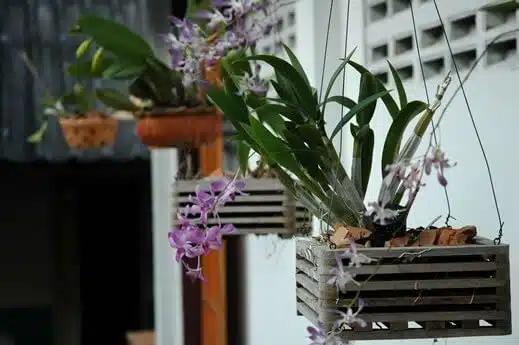
Ceramic pots, originally the only type available to collectors, were most commonly used before (and some time after) the invention of plastic. We have the Victorians to thank for designing pots with holes in them.
Plastic vs. Clay Orchid Pots
So how do you go about deciding between clay and plastic? (If you’re already decided on wood or wire then jump to the next section.)
Clay pots, with or without extra holes, are best for attentive growers. Clay breathes far better than plastic so orchid roots will benefit from increased aeration. Whilst orchids in clay pots will need regular, frequent watering, it will be virtually impossible to overwater them.
Plastic pots will retain more moisture (so are good if you regularly forget to water). They also let you keep an eye on the health of the roots. Orchid roots tend not to like sitting in water for long periods so it’s important to let plastic pots dry out between each watering. Plastic pots also have the benefit of allowing sunlight to reach the roots.
You can also buy plastic pots with lots of slats. These favour aeration over water-retention and are ideal for placing inside more decorative pots.
What About Wood and Wire Orchid Pots?
Wood and wire “baskets” are an alternative to plastic and terracotta pots and look excellent hung either inside or out (climate allowing).
As long as they’re left to fully drain in the sink or bath after watering, there’s no issue with hanging them indoors. They offer the best aeration but the downside is that the roots will dry out much quicker. In humid rainforest with regular downpours, this isn’t a problem. Your dry kitchen, however, is another matter.
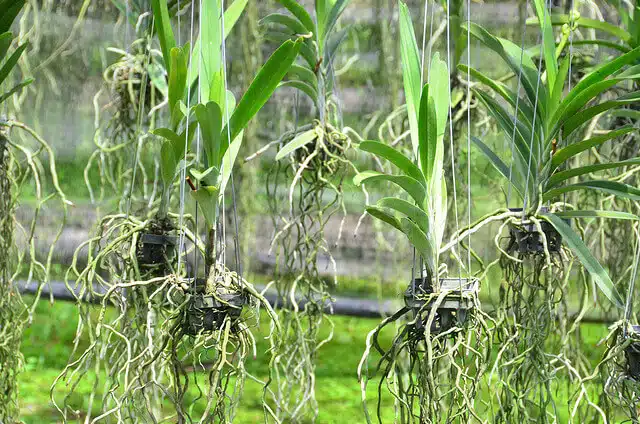
If you’re more the hands-off type, then the regular watering that orchids in open-slatted containers demand may mean that they’re not a viable option.
Do Different Orchids Need Different Pots?
You choice of pot should be dictated in part by the genus of orchid you’re growing. Different orchids favour different environments. Terrestrials like Paphiopedilum will favour a moister environment (think plastic) while epiphytes like Vanda should be given ample drainage.
5 Best Orchid Pots: My Favourites
***Full Disclosure – Where appropriate, I’ve linked product images to commercial sites and Amazon (see Amazon Disclosure). If you buy from these sites, I earn a small affiliate fee, which helps me keep Urban Turnip going.***
1. Standard 11cm Clear Pot (Pack of Ten)
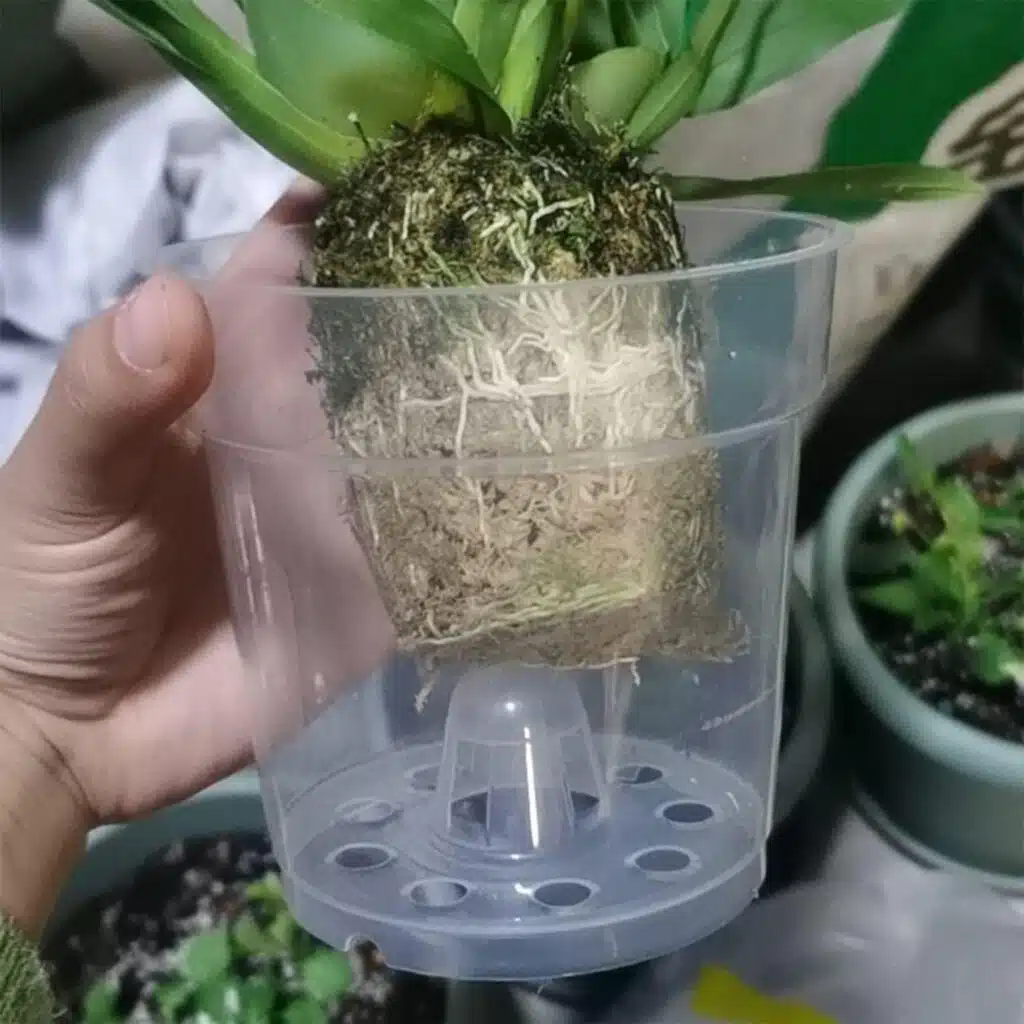
If you’re looking for a high-quality, inexpensive option then you can’t go far wrong with this product. You’ll get a pack of ten.
The pots have good drainage holes and a slatted dome that increases airflow to the roots. They’re suitable for hanging if that’s what you want to do (although I personally think the wood pots are better for that).
The pots in the pack have a height of 11cm, which is a good general size for most orchids. If you need bigger, have a look at other brands but look for the same design.
A common issue with these plastic pots is that can be flimsy and prone to splitting. This particular product, however, is very sturdy and durable.
2. Sun Bulb Cedar Basket
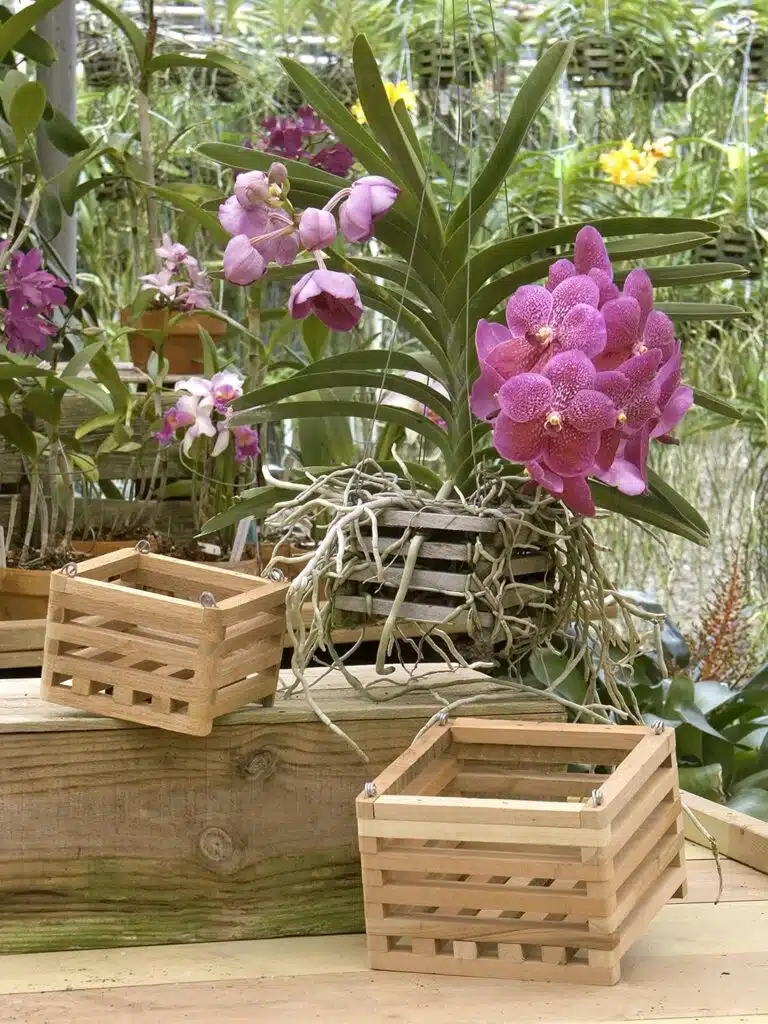
Of all the products on this list, this simple cedar basket is my personal favourite.
It’s well made (with hooks for hanging) but doesn’t look overdone. It still has a rustic, homemade feel about it. With a width/depth of 8 inches, it’s big enough to hold heavier orchids with tall blooming stems.
These pots are ideal for epiphytic orchids like Vandas. The slits aren’t too big either so will hold coarse bark well. The wood is treated, which means that the pot as a whole will stand up to repeated watering.
It’s a little on the pricier side but, in my opinion, is worth it for the aesthetic appeal.
3. HomArt Terracotta Pot
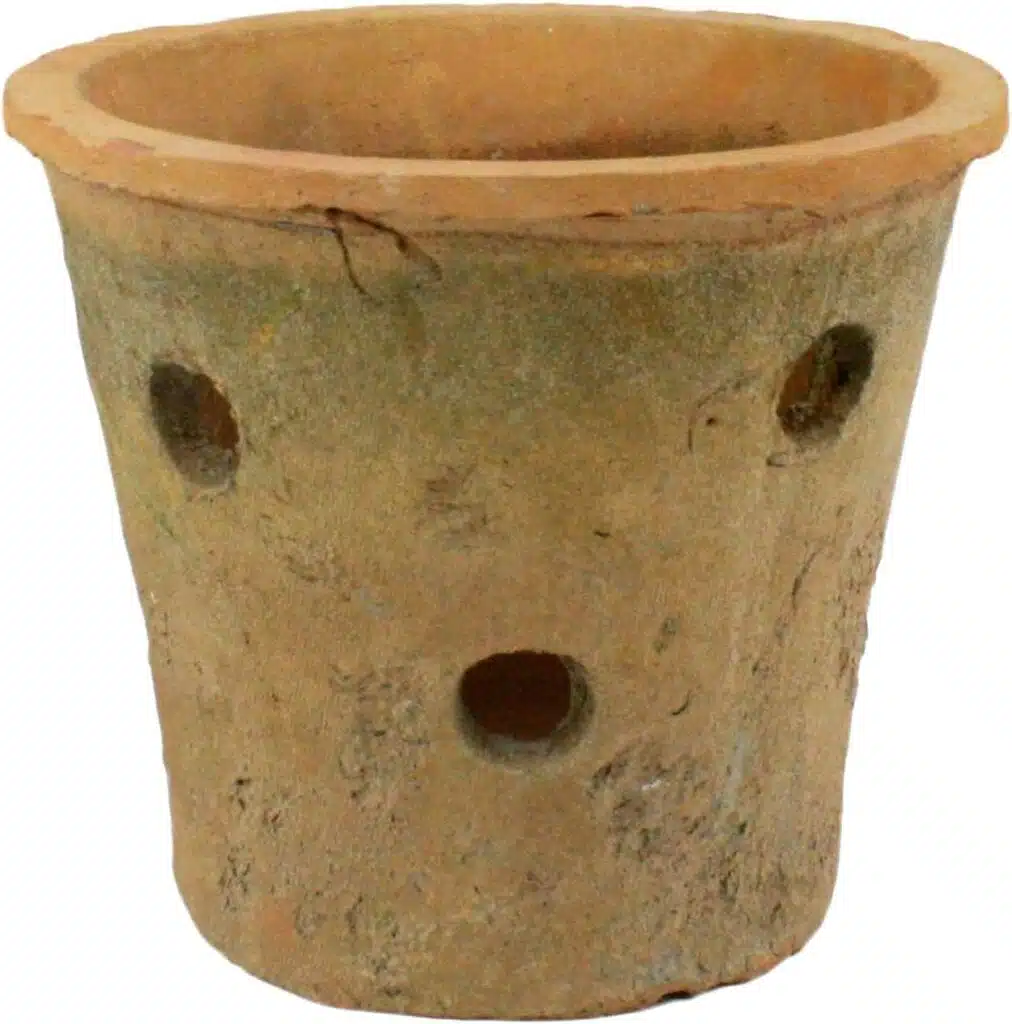
Terracotta orchid pots are expensive. I suspect it comes from the additional labour required to drill the holes. If you want simple terracotta, you’re probably better off buying a normal pot and drilling the holes yourself (there are tutorials online).
The holes are apparently a Victorian invention and they work brilliantly to improve the airflow over the roots of orchids. Err towards more epiphytic genera for this kind of pot.
That said, I’ve included this one because it’s attractive as a piece of art in its own right, and more than a normal pot with holes added.
Because these pots are handmade, each one is unique. They have a wonderful rustic feel about them (they don’t look as though they’ve just rolled off a production line).
It has a top diameter of 6 in. and a depth of 5 in. Matching drainage plates are also available. Because of the way they are made they do have quite a rough finish, so might scratch smooth surfaces.
4. Orchid Pot With Drainage Holes (Orchify on Etsy)
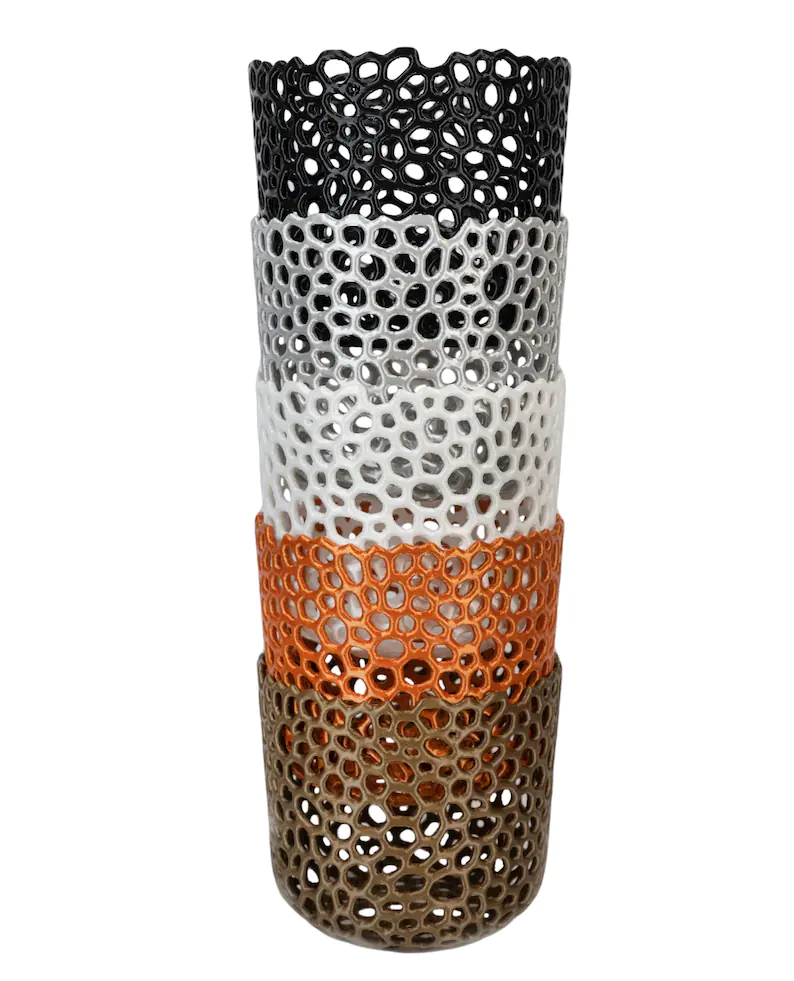
I’ve included these orchid pots, a range of bestsellers on Etsy, because they’re so unique ad something of a statement.
They won’t be to everybody’s taste. But if you do like them, they make excellent pots from a purely practical point of view.
You can choose from a range of sizes, 3.5 inches to 7 inches tall, and five different colours.
Because of the main drainage holes, these pots are better sited to orchids with rough growing media. Keep in mind that the pots are plastic, not ceramic.
5. Beige & Green Medium Orchid Pot (Beth Larcombe on Etsy)
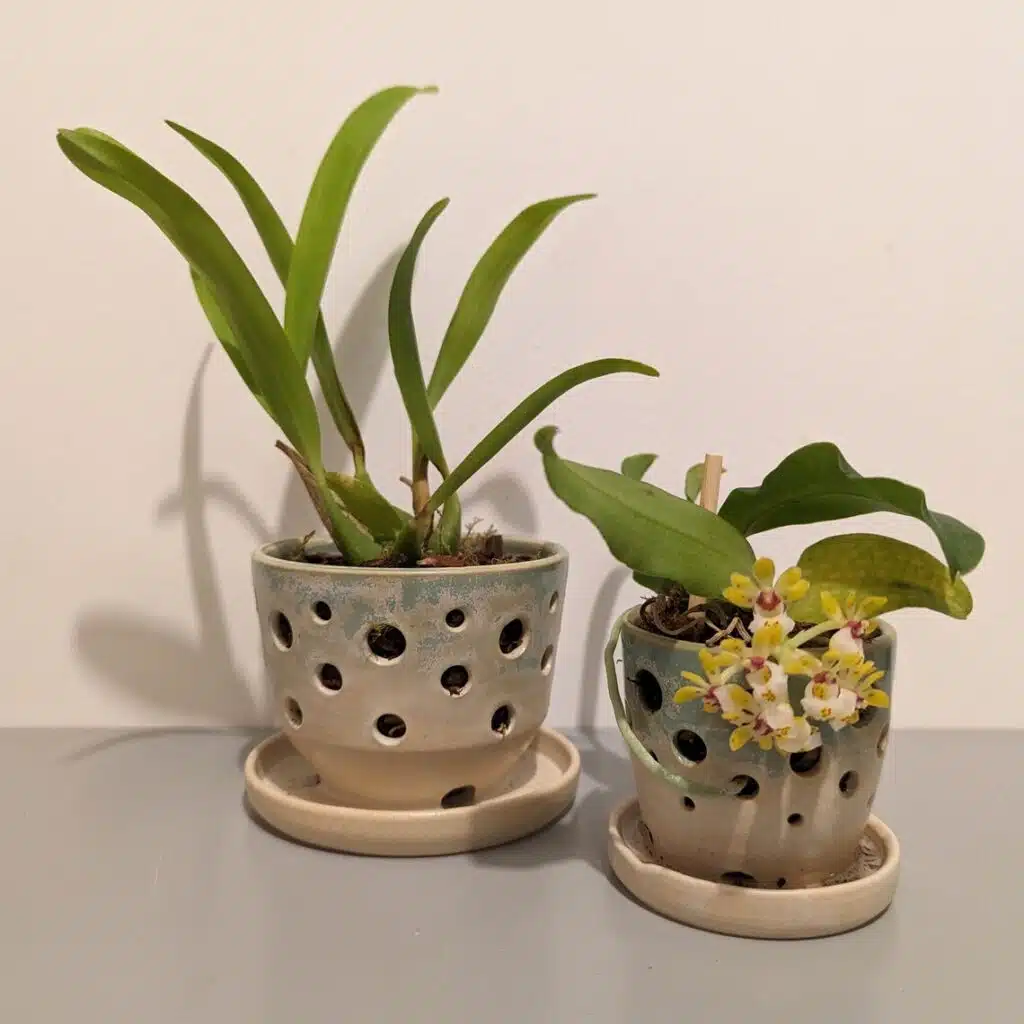
To round off, I’ve included another from Etsy. These pots are perfect if you’re looking for a glazed ceramic pot with a drainage tray.
They’re 8 cm high (they come in one size) so only suitable for smaller orchids.
They’re all handmade and make a beautiful addition to an indoor orchid garden. A pot like this could easily last a lifetime.
What Are Your thoughts? Leave a Comment Below!
What are your thoughts? Have you tried any of the pots on this list? Leave a comment below and let me know!
Resources and References
Types of growing pots for orchids: clay vs. plastic
Orchid Wall by spinster cardigan; Hanging Orchids by Audrey Scott; Hanging Orchids by Robert Schrader.
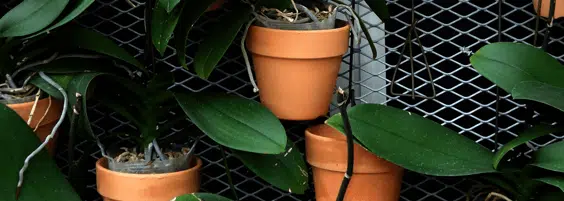
Growing up in Hawaii with a mother that grew hundreds of orchids the one medium that stands out to me is called Hapu’u which was from a fern in the forest. The orchids just rooted in them well. But now they are threatened to the brink of extinction so that is no longer an option. But they grew beautifully in her hot house as well as haleconia.
The wood boxes were also used filled with fragments of hapu’u. So my choice would be the wooden cedar boxes filled with bark or the ceramic pots with holes. All great choices. Thanks for your info. Enlightening.
Hey Melinda, what a wonderful story 🙂 I wonder if it might be possible to replace Hapu’u with a similar fern, as the mix of bark and softer medium does seem to work very well.
of the recommended pots, any particular type you would favor for brassolaeliocattleya? I’ve always had phalaenopsis up until now, and am planning for a couple of years down the road with this new-to-me orchid.
Hey Rebecca, my understanding is that Cattleyas like things quite dry (or rather not overly wet) so a clay pot with holes in might be the way to go. I’d avoid the moisture holding plastic ones.